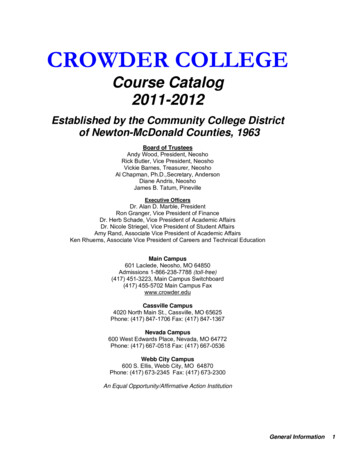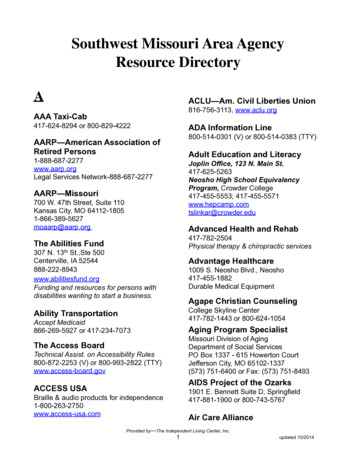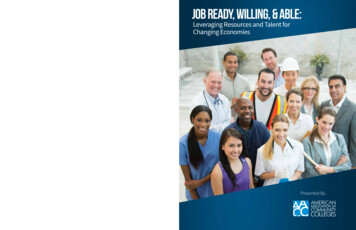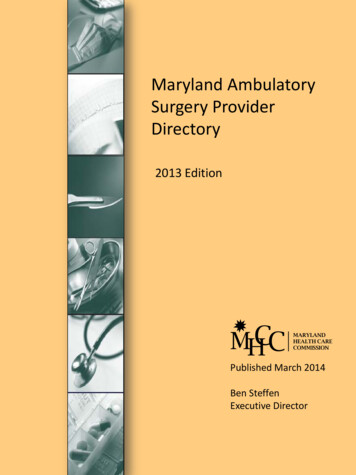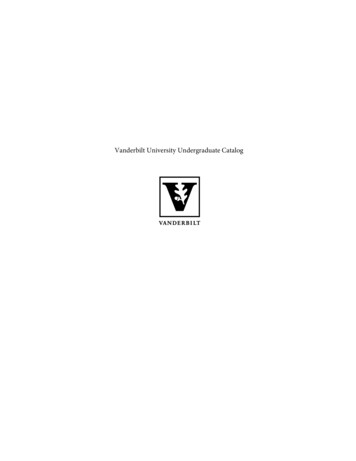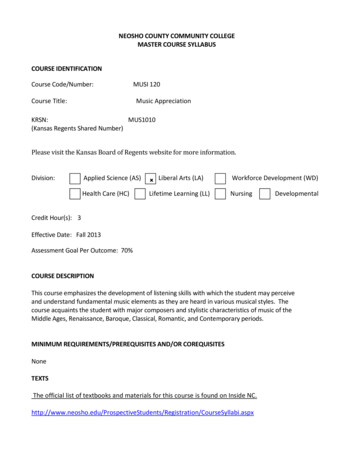
Transcription
NEOSHO COUNTY COMMUNITY COLLEGEMASTER COURSE SYLLABUSCOURSE IDENTIFICATIONCourse Code/Number:Course Title:MUSI 120Music AppreciationKRSN:MUS1010(Kansas Regents Shared Number)Please visit the Kansas Board of Regents website for more information.Division:Applied Science (AS)xHealth Care (HC)LifetimeLearning (LL)xxxCredit Hour(s): x3Effective Date: Fall 2013Assessment Goal Per Outcome: 70%xLiberal Arts (LA)Workforce Development (WD)xxxxNursingDevelopmentalxxxxxxxCOURSE DESCRIPTIONThis course emphasizes the development of listening skills with which the student may perceiveand understand fundamental music elements as they are heard in various musical styles. Thecourse acquaints the student with major composers and stylistic characteristics of music of theMiddle Ages, Renaissance, Baroque, Classical, Romantic, and Contemporary periods.MINIMUM REQUIREMENTS/PREREQUISITES AND/OR COREQUISITESNoneTEXTSThe official list of textbooks and materials for this course is found on Inside tration/CourseSyllabi.aspx
GENERAL EDUCATION OUTCOMES1. Practice Responsible Citizenship through: identifying rights and responsibilities of citizenship, identifying how human values and perceptions affect and are affected by social diversity, identifying and interpreting artistic expression.2. Live a healthy lifestyle (physical, intellectual, social) through: listing factors associated with a healthy lifestyle and lifetime fitness, identifying the importance of lifetime learning, demonstrating self-discipline, respect for others, and the ability to work collaboratively as ateam.3. Communicate effectively through: developing effective written communication skills, developing effective oral communication and listening skills.4. Think analytically through: utilizing quantitative information in problem solving, utilizing the principles of systematic inquiry, utilizing various information resources including technology for research and data collection.COURSE OUTCOMES/COMPETENCIES (as Required)The learning outcomes and competencies detailed in this course outline or syllabus meet or exceedthe learning outcomes and competencies specified by the Kansas Core Outcomes Groups project forthis course as approved by the Kansas Board of Regents.By the end of the course, the student should be able to:1.2.3.4.5.Identify and describe the elements of melody, harmony, pitch, rhythm, timbre, texture, form, anddynamics.Identify the expressive qualities of the elements of music through listening experiences.Describe the general characteristics of musical genres and the relationship to theircultural/historical settings.Demonstrate knowledge of musical artists, composers, and compositions related to the context ofthe course.Critically evaluate the role of music in their lives.MINIMUM COURSE CONTENTThe following topics must be included in this course. Additional topics may also be included.I. Music As An Art FormA. Definitions; originsB. How music affects the individualC. How music affects society/cultureD. Careers in music
II. The Mechanics of MusicA. Acoustics – The science of soundB. PitchC. RhythmD. MelodyE. HarmonyIII. Listening to MusicA. TimbreB. InstrumentsC. Form in musicD. Attending concertsIV. Music of the Middle AgesA. ChantB. Early polyphonyC. Secular and instrumental musicD. Ars Nova vs. Ars AntiquaV. Music of the RenaissanceA. Historical perspectiveB. Sacred musicC. Secular musicVI. Music of the Baroque eraA. General characteristicsB. Vocal musicC. Instrumental musicVII. Music in the Classical eraA. General characteristicsB. Instrumental musicC. Chamber musicD. Vocal musicIX. Music in the Romantic periodA. General characteristicsB. Instrumental musicC. Vocal musicD. Musical theaterX. Music of the 20th CenturyA. General characteristicsB. Forms and genresXI. Music in AmericaA. Pop musicB. Musical theaterC. JazzD. American concert and experimental music
STUDENT REQUIREMENTS AND METHOD OF EVALUATIONINSTRUCTIONAL METHODS1. Lecture2. Demonstration3. Critical listeningSTUDENT REQUIREMENTS AND METHOD OF EVALUATION1. Quizzes and Exams2. Concert Reports3. Research ProjectGRADING SCALE90-100%-A, 80-89%-B, 70-79%-C, 60-69%-D, 59% and below-FASSESSMENT OF STUDENT GAINThe purpose of assessing student learning at Neosho County Community College is to ensure theeducational purposes of the institution are met and appropriate changes are made in programdevelopment and classroom instruction to allow for student success. The instructor(s) of this coursewill determine the methods of assessment most appropriate and complete an assessment report atthe end of the course.Assessment of student gain is determined by the administration of a Pre- and Post-Assessmenttest. The Pre-Test will be given to each student prior to the beginning of instruction in eachcourse, and the Post-Test will be administered following the conclusion of instruction in eachcourse. These results will then be compiled and appropriate analyses undertaken.Attendance Policy1. NCCC values interactive learning which promotes student engagement in the learning process. Tobe actively engaged, the student must be present in the learning environment.2. Unless students are participating in a school activity or are excused by the instructor, they areexpected to attend class. If a student’s absences exceed one-eighth of the total course duration,(which equates to one hundred (100) minutes per credit hour in a face-to-face class) the instructorhas the right, but is not required, to withdraw a student from the course. Once the student hasbeen dropped for excessive absences, the registrar’s office will send a letter to the student, statingthat he or she has been dropped. A student may petition the chief academic officer forreinstatement by submitting a letter stating valid reasons for the absences within one week of theregistrar’s notification. If the student is reinstated into the class, the instructor and the registrarwill be notified. Please refer to the Student Handbook/Academic Policies for more information
3. Absences that occur due to students participating in official college activities are excused except inthose cases where outside bodies, such as the State Board of Nursing, have requirements forminimum class minutes for each student. Students who are excused will be given reasonableopportunity to make up any missed work or receive substitute assignments from the instructorand should not be penalized for the absence. Proper procedure should be followed in notifyingfaculty in advance of the student’s planned participation in the event. Ultimately it is thestudent’s responsibility to notify the instructor in advance of the planned absence.ACADEMIC INTEGRITYNCCC expects every student to demonstrate ethical behavior with regard to academic pursuits.Academic integrity in coursework is a specific requirement. Definitions, examples, and possibleconsequences for violations of Academic Integrity, as well as the appeals process, can be found in theCollege Catalog, Student Handbook, and/or Code of Student Conduct and Discipline.ELECTRONIC DEVICE POLICYStudent cell phones and other personal electronic devices not being used for class activities must notbe accessed during class times unless the instructor chooses to waive this policy.NOTE:Information and statements in this document are subject to change at the discretion of NCCC.Students will be notified of changes and where to find the most current approved documents.NOTE:If you are a student with a disability who may need accommodation(s) under the Americans withDisabilities Act (ADA), please notify studentdevelopmentteam@neosho.edu, Chanute Campus, 620431-2820, ext. 213., or Ottawa Campus, 785-242-2067 ext. 305, as soon as possible. You will need tobring your documentation for review in order to determine reasonable accommodations, and then wecan assist you in arranging any necessary accommodations.COURSE NOTES
D. Ars Nova vs. Ars Antiqua V. Music of the Renaissance A. Historical perspective B. Sacred music C. Secular music VI. Music of the Baroque era A. General characteristics B. Vocal music C. Instrumental music VII. Music in the Classical era A. General characteristics B. Instrumental music C. Chamber music D. Vocal music IX.
